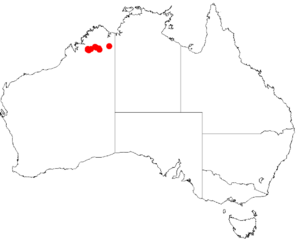Acacia capillaris facts for kids
Quick facts for kids Acacia capillaris |
|
|---|---|
| Conservation status | |
| Scientific classification | |
| Genus: |
Acacia
|
| Species: |
capillaris
|
 |
|
| Occurrence data from AVH | |
Acacia capillaris is a special kind of shrub, a small bushy plant, that belongs to the Acacia family. It's found only in a small part of northwestern Australia, which means it's endemic to that area.
What Does It Look Like?
This upright shrub usually grows to be about 0.4 to 1 metre (1 to 3 ft) tall. Its stems are covered in long, soft hairs, each about 1 mm (0.039 in) long.
Leaves and Flowers
Like most Acacia plants, it doesn't have regular leaves. Instead, it has special leaf-like parts called phyllodes. These phyllodes are arranged in groups of 14 to 18, standing upright. They are about 5 to 9 mm (0.20 to 0.35 in) long and also have soft, white hairs.
The plant blooms in May, showing off bright yellow flowers. These flowers grow in round clusters, with each cluster holding about 15 to 20 flowers.
Seed Pods
After the flowers, the plant grows seed pods. These pods are smooth and brown. They are flat and long, measuring about 1.5 to 4 cm (0.59 to 1.57 in) in length and 4 to 4.5 mm (0.16 to 0.18 in) in width. The edges of the pods are thicker. Inside, you'll find two to eight black seeds, each about 3.5 mm (0.14 in) long.
How Was It Named?
The plant was first officially described by a botanist named Alexander Segger George in 1999. He wrote about it in a scientific paper called Seven new species in Acacia section Lycopodiifolia (Mimosaceae).
Later, in 2003, another botanist, Leslie Pedley, gave it a new name, Racosperma capillare. But then, in 2006, it was moved back to the Acacia family.
The very first sample of this plant, called the type specimen, was collected by R.J.Cranfield in 1988. It was found near Fern Creek in the Wunaamin Miliwundi Ranges.
Where Does It Grow?
Acacia capillaris is found in the Kimberley region of Western Australia. It likes to grow on steep, rocky slopes or along creek beds. It prefers red-brown clay soils, often found over granite rock.
You can often spot it around Mount Bell and Scott Gorge in the West Kimberley area. It usually grows as a smaller plant under taller Livistona palms. It's part of the savannah or spinifex plant communities there.


